ANG: boogie-woogie, boogie woogie, Boogie-Woogie 1928; NEM: Boogie-Woogie, pianistischer Stil (12 Takte); FR: boogie-woogie, boogie woogie, style pianistique (12 mesures); IT: boogie-woogie, boogie woogie, stile pianistico (12 battute).
ET: »Woogie« kot rima z »boogie« = slabšalno ime za črnca (‹DUD›, 92).
D: »(Naziv za) stil interpretacije ♦bluesa♦ na klavirju s perkusivno ostinatno spremljavo v levi roki …
Ponavljanje obrazca v basu skozi dva ali tri takte, ki predstavlja dvanajsttaktno progresijo v ♦bluesu♦, včasih s IV. v drugem ali desetem taktu. Melodije lahko vsebujejo vrst figur ki se ponavljajo z uporabo osnovnega ♦beata♦ (s tremolo, ♦riffi♦, hitrimi triolami) ali s ♦poliritmično♦ ♦improvizacijo♦. Ta stil je cvetel okrog leta 1936 do zgodnjih štiridesetih let, ko so odkrivali izvajalce iz dvajsetih let, kot sta npr. Lewis in A. Ammons. Basovska linija je preživela v ♦bluesu♦, ♦rhythm and bluesu♦ in v ♦rocku♦.« (‹RAN›, 102)
KM: Ustreznice v ANG, NEM, FR in IT, ki se razlikujejo od izvirnika, so navedene v ‹BR›, 234–235, vendar ne kot prevedki, temveč kot pojasnila. V ‹L›, 74, so samo izvirni ANG-pojmi in nepraktično tudi drugi opisi v NEM, FR in IT.
KR: Pojem se večrat piše brez vezaja.
GL: ♦blues♦, ♦jazz♦, ♦rhythm and blues♦, ♦rock, rock glasba♦, ♦walking bass♦.
‹APE›, 34–35; ‹BASS›, I, 382; ‹BKR›, I, 160; ‹FR›, 11; ‹GRJ›, I, 135–136; ‹GR6›, III, 39; ‹HI›, 70; ‹HK›, 64–65; ‹IM›, 45; ‹KN›, 42; ‹LARE›, 176; ‹MELZ›, I, 220; ‹P›, 37; ‹RIC›, I, 294; ‹RL›, 118

